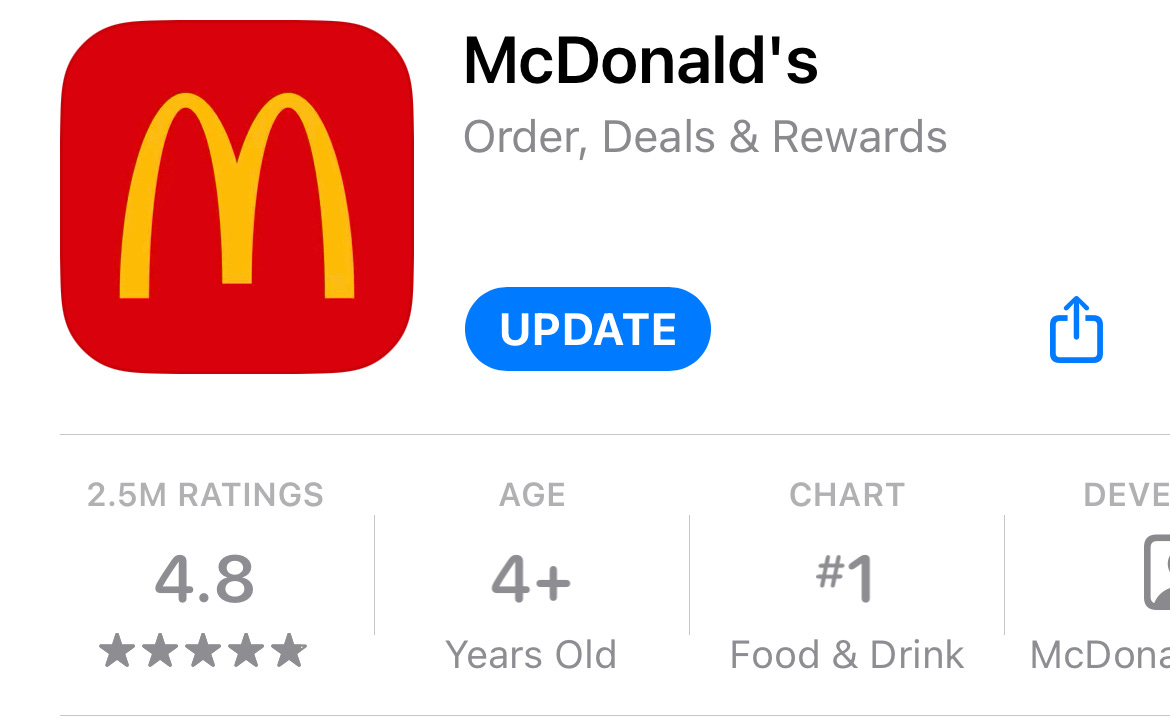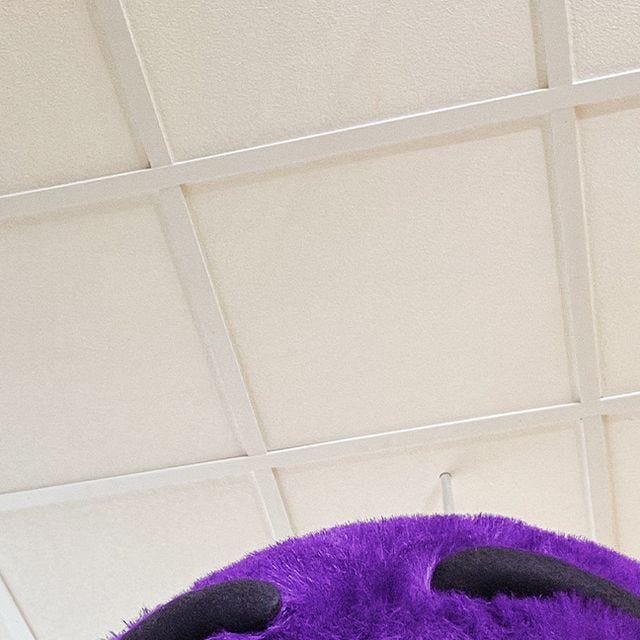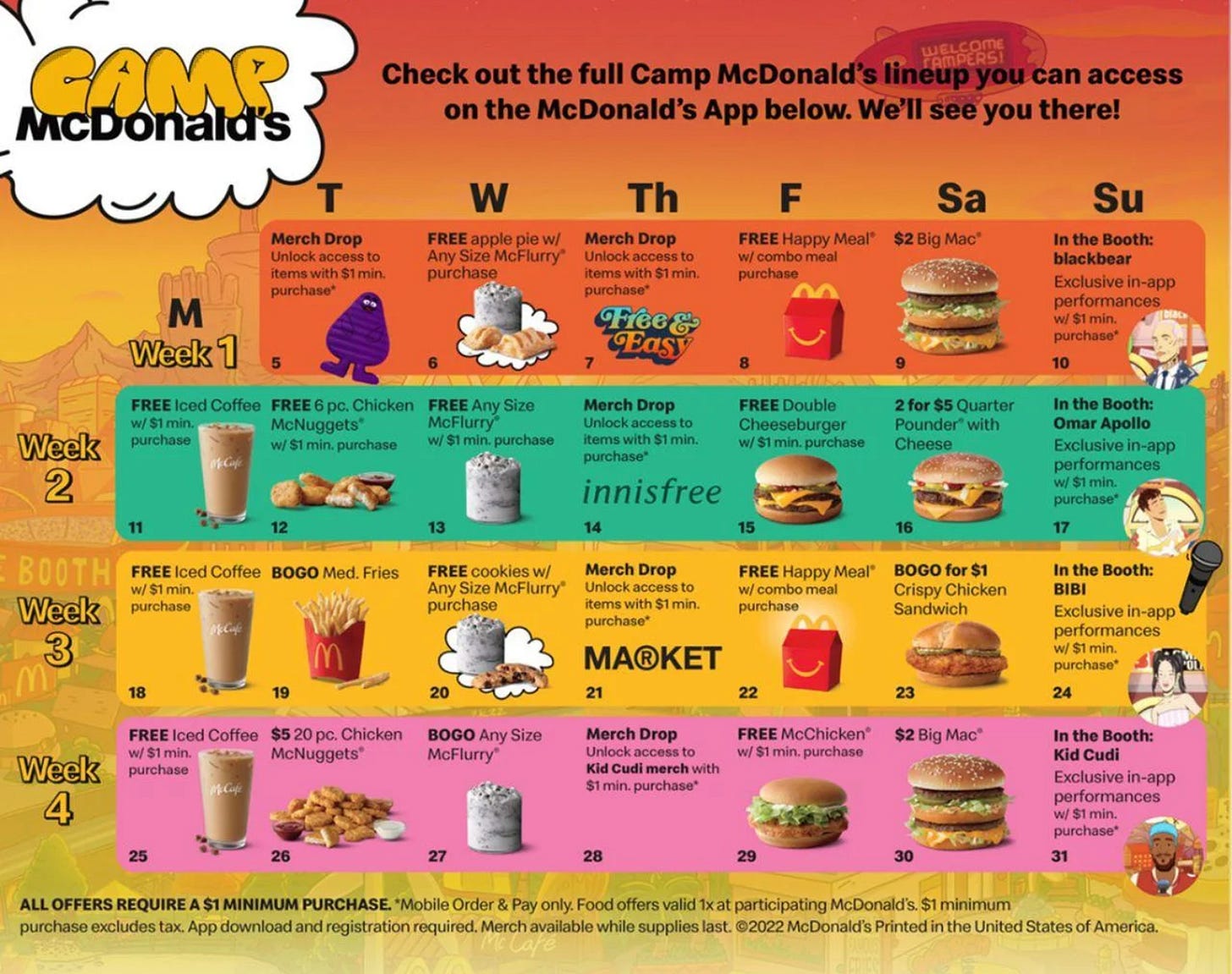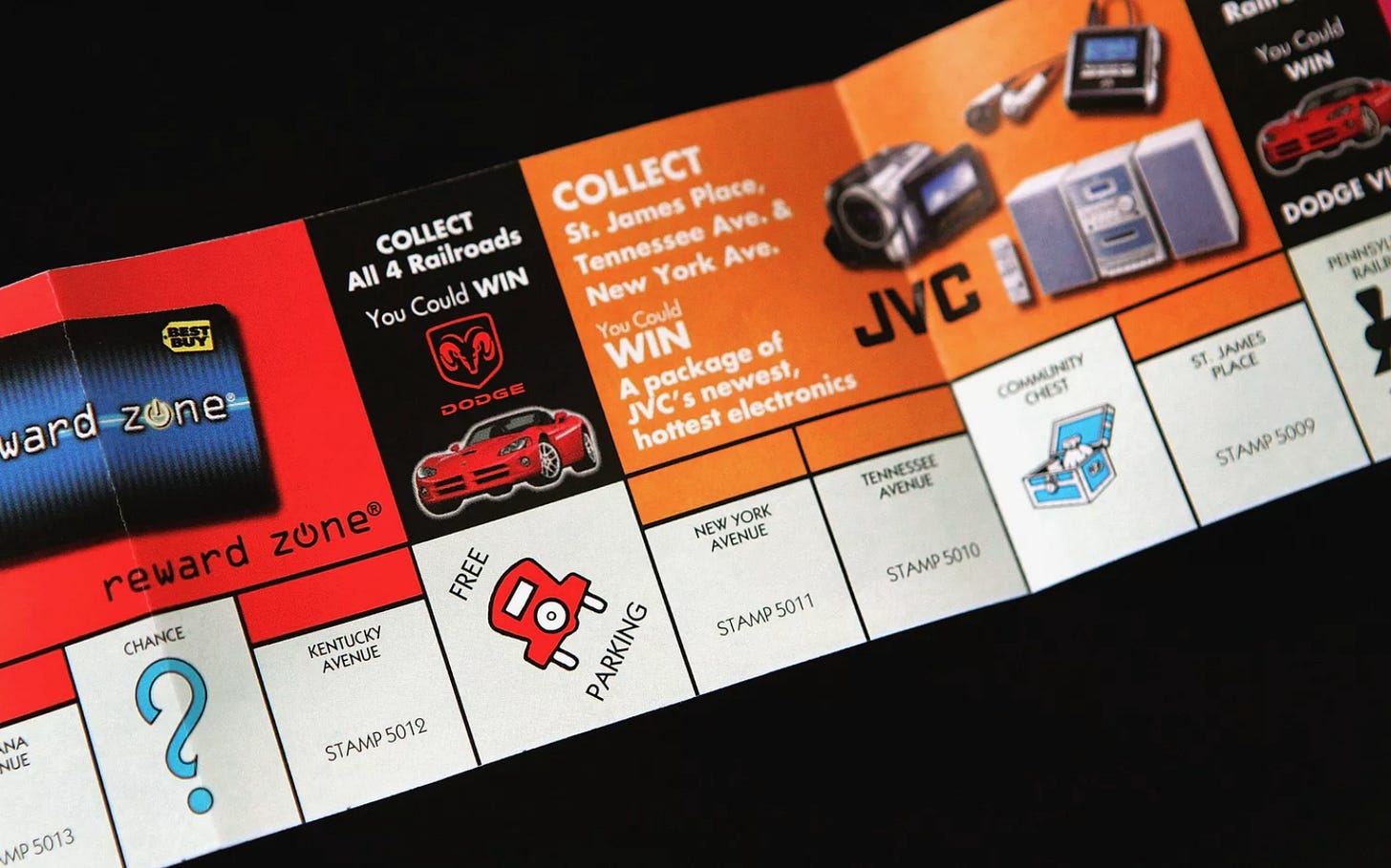#211: Creating a Web3 Campaign for McDonald's
🍔🍟 Why the fast food industry needs to adopt web3
I’m not sure how it started, but I decided that it would be a fun thought exercise to explore what a web3 campaign for a fast food brand like McDonald’s would look like.
Maybe it’s because my fiancée A and I grabbed some McDonald’s last weekend. Or maybe it’s because
shared with me that he bought a McDonald’s Chicken McNugget toy on eBay that was only available in China a couple weeks ago.Maybe it’s because I’m seeing McDonald’s ads on my Twitter feed. They are currently celebrating Grimace’s birthday and pushing the Grimace Birthday Meal, yum.
Imagine starting a marketing campaign with a gibberish tweet. That is the power of McDonald’s and their intimate understanding of Internet culture.
All this Mcdonald’s inception led me to tweeting this a couple days ago:
Some folks replied with web3 efforts from Taco Bell, QuikTrip, and a Brazilian burger chain. However, I wasn’t satisfied. I was hungry for a full-fledged campaign and effort from a juggernaut in the space, like McDonald’s.
Before I dive in, there are some caveats with this thought exercise:
It’s possible McDonald’s already has web3 efforts on its roadmap. This would likely take months, possibly years to roll out. The company filed an application for 10 trademarks last February related to virtual goods and virtual restaurants, so there’s interest at a minimum.
McDonald’s is a franchised business, meaning the company itself doesn’t run operations for most of their locations. They work with franchisees to implement major initiatives, which may have operational and coordination risks. There needs to be buy-in across the board for an effective broader effort. I’m assuming that franchisees would be on board with this hypothetical web3 campaign.
Because this is a phygital effort, there may be physical limitations at a larger scale. There are pros and cons to this, but making the physical side operate in lock-step with the digital side is key. If done successfully, a whole new growth flywheel will be implemented along with a larger moat against competition.
With that said, let’s get into it. Fortunately, I just finished lunch so I’ll be able to resist the temptation of ordering fast food while staring at all these pictures. Can’t say the same by the time I finish writing this piece though.
Why should McDonald’s explore web3?
As large brands like Nike and Starbucks have entered web3 over the past year, a couple of themes stuck out to me:
These companies have their own account and loyalty programs. Starbucks has Starbucks Rewards, and Nike has the Nike account, SNKRS app, Nike Run Club, and Nike Training Club. These brands have a 360-degree understanding of their customer, and want to get a higher fidelity version of that while building deeper relationships with them via web3.
These brands have a physical presence globally. Similar to blockchains (alright maybe a stretch, but bear with me), they have a distributed network of nodes (physical locations) that can augment the experiences they are pushing. These brands are pushing from physical to digital, and can roundtrip it back to the physical space.
McDonald’s fits in with these themes as well:
McDonald’s launched their rewards program in July 2021, with a total of 40 million app downloads in 2022. They may be late to the mobile app party, but they’re catching up fast with understanding their consumer base from the digital POV. In fact, they’re the #1 downloaded app in the Food & Drink category in the Apple App Store right now, likely due to the Grimace campaign.
There are 38,000 locations in over 100 countries. A distributed network of physical locations allows for unique local, regional, and global web3 campaigns to take place if they were to pursue them.
Lastly (and possibly most importantly), McDonald’s gets Internet culture and is leaning hard into it. Why?
To capture the Gen Z market of course ✨
One of the best ways to see this in action is with their social media accounts.
McDonald’s launched the Grimace campaign with selfie posts from the clumsy but lovable character, and they went viral.
Additionally, McDonald’s has run several campaigns catering to younger audiences (and adults that are young at heart like myself 😇):
2020: McDonald’s partnered with rapper Travis Scott for the Travis Scott Meal
2021: McDonald’s partnered with rapper Saweetie for the Saweetie Meal
2022: McDonald’s released the Adult Happy Meal in partnership with popular street brand, Cactus Plant Flea Market
2022: McDonald’s launched Camp McDonald’s, a month of deals, merch, and music experiences, all in the app.
We see additional examples of how McDonald’s is in tune with pop culture and can create cult fandoms on their own with the McRib and Szechuan sauce (revived by Rick and Morty).
These examples show that priorities are shifting towards:
Attracting a younger audience and converting them into lifetime customers
Onboarding customers to the mobile app
Growing a collectibles mindset (Chicken Nugget Tetris toy, Adult Happy Meals, limited edition merch) that combines novelty with brand affinity
Implementing Web3 technology can enhance, expand, and empower these capabilities even further, and the McDonald’s app is the ground floor for the web3 house that could be built.
McDonald’s Strategic Direction
This is great and all, but why should McDonald’s even listen to this dumb thought exercise from TPan?
PS: If anyone does know folks at McDonald’s, send this over to them. I want to see what they think about this lol 🙏
In McDonald’s 2022 annual report, they shared their growth pillars:
Maximize Marketing: Invest in new, culturally relevant approaches, grounded in fan truths.
Commit to the Core: Tap into customer demand for the familiar and focus on serving their core products (Fries, Big Mac, Chicken McNuggets, and McFlurry).
Double Down on the 4D’s: Digital, Delivery Drive Thru, and Restaurant Development
Digital - Expand upon the digital experience growth engine. McDonald’s has loyalty programs in over 50 markets globally and nearly 50 million active loyalty members in the top six markets in the last 90 days (28 million of them in the US).
Delivery - 35,000 of their restaurants have delivery capabilities through last mile partners like UberEats, and DoorDash.
Drive Thru - 26,000 restaurants have drive thrus. 95% of US locations have drive thrus.
Restaurant Development - McDonald’s plans to open ~1,900 new restaurants globally
Note that the first letter of each of these pillars spells out MCD, McDonald’s stock ticker. Cute.
More importantly, I believe investing in and building out a web3 program actually hits all of these growth pillars.
How would I roll out McDonald’s web3 program?
I would break this out into 3 phases: Crawl, Walk, Run. Each stage of the web3 integration would require more preparation and operational considerations.
Crawl
The McPass
The McPass is a limited supply on-chain collectible that provides dynamic benefits to its holders. How could the benefits be tested and structured?
New products: If there is a new product being launched, eg: The Justin Bieber meal, holders can use their pass to receive a free meal.
An exclusive monthly offer: Holders can choose their monthly perk and redeem it at their local McDonald’s through the app.
Point multiplier: Customers earn 100 points for every $1 spent on the app. McPass holders earn double.
Access to regional-exclusive items: Are you a die-hard McDonald’s collectibles fan? Do you wish you could get that China-exclusive Chicken McNugget Tetris toy? Get exclusive access to them as a McPass holder.
With these types of perks, the McPass shouldn’t be free. McDonald’s can understand their customers’ appetite for paying for digital items if the value prop is strong enough.
Large brands are exploring what this looks like, and McDonald’s should as well.
This could be time-bound (eg: a 2-year pass) or active forever. Imagine gifting your McPass to your grandkids, this could become a family heirloom!
Partnered digital collectibles
As more brands and celebrity figures are dipping their toes into web3, McDonald’s can create special partnered NFTs digital collectibles. These collectibles can provide perks within the McDonald’s ecosystem and campaign and outside of it while being co-branded.
For example, McDonald’s could release a special McDonald’s x Justin Bieber digital collectible that provides a free Justin Bieber meal, and also exclusive perks with Justin Bieber’s next concert tour (tickets, merch, etc.) and other associated brands (eg: Bieber’s Drew clothing brand).
Walk
The Virtual Happy Meal
This could be a weekly engagement campaign to encourage customers to come back to the app regularly. Many apps have a form of this to encourage habit-building, and McDonald’s should do the same.
Because these Happy Meals are digital, the contents can be dynamic and support the promotion of broader efforts, eg: Grimace’s birthday.
Complete the whole set of digital collectibles and unlock a special offer that you can redeem at your local McDonald’s.
Special experiences at web3 conferences:
This sounds mundane, but I believe there is a blue ocean opportunity here, especially as web3 is still in its infancy. Having a presence at, and building special experiences for a web3-native audience will give McDonald’s (or any brand for that matter) an edge:
Have access to and grab the attention of strategic players in the web3 ecosystem
Get earned media from industry-specific publications, influencers, and participants
Build relationships with web3 native brands in attendance for potential future partnerships
Plus…McDonald’s is in the business of food, and conference attendees have to eat 😉
Run
This is where things get fun.
McDonald’s Monopoly 3.0
Remember McDonald’s Monopoly? It’s time to give that game a major upgrade.
Creating a web3 version of this game not only complements the company’s push in digital, but it also:
Opens up a new market opportunity for trading pieces on a secondary market. McDonald’s can earn a royalty from sales which could fund the prizes, while also having more winners (pushing the virality of the campaign).
Prevents fraud. Decades ago, the McDonald’s Monopoly game uncovered a fraud scheme where individuals stole game pieces and won the most valuable prizes, netting over $24 million. Game pieces can be verifiably randomized on-chain.
Open up opportunities for long-term engagement. For example, what if you could burn 2022 game pieces for 2023 pieces at a rate of 3:1? You could also layer on other engagement requirements to qualify for the burn.
The Chicken McNugget Quest
This one’s fun because A LOVES Chicken McNuggets, but also because of the way the menu item is structured. In the US, you can purchase Chicken McNuggets in quantities of 4, 6, 10, 20, or 40.
What if you could create a scavenger hunt mini-game (eg: go to 10 different McDonald’s locations and make a qualifying purchase through the app) and earn game pieces to complete a Chicken McNugget set?
If you complete the 4/6/10/20/40 piece set, you get a special digital collectible that allows you to redeem it for that calendar year:
4-piece set completion: Get a free 4-piece Chicken McNuggets 4 times for the year
6-piece set completion: Get a free 6-piece Chicken McNuggets 6 times for the year
And so on…
McDAOnald’s
This is my proudest idea by name alone 😂
Create a DAO based on the customer’s reward points. Points will be separated into transactional and lifetime points.
Transactional points: Standard points system where points are earned via purchases and redeemed for food
Lifetime points: This is a cumulative point total based on the customer’s lifetime app purchases. These points are converted to an ERC-20 governance token for McDAOnald’s.
McDAOnald’s would be an independent entity that would support and inform the company with business decisions.
If McDonald’s brought back one legacy menu item in 2024, which one should it be?
Which music artist should McDonald’s partner with next?
Which regional-exclusive collectible should also be sold in the US?
These DAOs would be country-specific and would become a better version of a consumer preference survey.
How is success measured?
The KPIs for success could go several layers deep, but at the end of the day, do these web3 efforts drive incremental sales?
On top of that, can new revenue channels be created?
Primary sales of digital collectibles
Secondary royalties
Lastly, do these efforts support the shift towards a digital experience and loyalty program that McDonald’s is pushing globally while increasing brand affinity?
I think it could, and being a first mover will help.
Although this thought exercise I’ve spun up is for McDonald’s, the concepts could apply to many other large QSR (quick service restaurant) chains.
Consumer relationships are evolving from periodic transactions to deeper relationships. Web3 helps to make these relationships transition in a way that previous models couldn’t.
See you next week!













Hmm should I do a parody version of this for Carl's Jr...
Nice post!
You should check their metaverse world at spatial: https://www.spatial.io/s/McDonalds-Lunar-New-Year-Experience-63bb3736f2513ed236ed3162
It's interesting to see they're already innovating in this industry